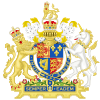Richard Weston, 1st Earl of Portland
James I Charles I | |
|---|---|
| Preceded by | The Lord Brooke |
| Succeeded by | The Lord Barrett of Newburgh |
| First Lord of the Admiralty | |
| In office 1628–1635 | |
| Monarch | Charles I |
| Preceded by | Office established |
| Succeeded by | Robert Bertie, 1st Earl of Lindsey |
| Personal details | |
| Born | 1 March 1577 Roxwell, Essex, England |
| Died | 13 March 1634/1635 (aged 56-58) |
Richard Weston, 1st Earl of Portland,
James I and Charles I, being one of the most influential figures in the early years of Charles I's Personal Rule
and the architect of many of the policies that enabled him to rule without raising taxes through Parliament.
Biography
Weston was the eldest son and heir of Sir Jerome Weston,
Member of Parliament (MP) for a number of constituencies including Maldon (1601–1603), Midhurst (in the parliament of 1604–1611), Essex (in the Addled Parliament of 1614), Arundel (1622), Bossiney (1624), Callington (1625) and Bodmin (1626).[1]
He was knighted in 1603.
During the reign of
Henrietta Maria for refusing grants to her favourites. He opposed wars with Spain in 1623 and France in 1626, but managed to find ways of raising the money to fund them when required, even when it was impossible to secure the cooperation of Parliament.[2]
Weston was elevated to the peerage on 13 April 1628 as
Lord Treasurer of England and invested with the Order of the Garter.[3] His policies proving highly unpopular, he escaped impeachment in 1629 only by the dissolution of Parliament. Nevertheless, he played an important role in the King's Personal Rule without Parliament, finding new sources of revenue while preventing any further increase in the King's expenditure, and being for a time the most influential of Charles's advisers. He persuaded the King to make peace with France in 1629 and Spain in 1630, removing the biggest drain on the treasury, and to sign the secret treaty with Spain in 1634. By the time he died in 1635, the Crown was solvent.[4]

On 17 February 1633, Weston was created
Jeremy Clarke, became a Governor of Rhode Island
in the American colonies.
On his death, he was succeeded by his second but eldest surviving son, Jerome.[7]
References
- ^ "History of Parliament". Retrieved 10 October 2011.
- ^ Kenyon, J. P. The Stuarts B.T. Batsford Ltd. 1959 p.72
- ^ Cokayne Complete Peerage 2000 Reprint Vol.1, p. 428
- ^ Kenyon, J.P. Stuart England Penguin Books 1990 reissue p.126
- ^ Lee, Sidney, ed. (1894). . Dictionary of National Biography. Vol. 40. London: Smith, Elder & Co. p. 234.
- ^ Mosley, editor Burke's Peerage 107th Edition 2003 Vol 1 p.1084
- ^ Burke's Peerage p.1084
Sources
- Lee, Sidney, ed. (1899). . Dictionary of National Biography. Vol. 60. London: Smith, Elder & Co.


